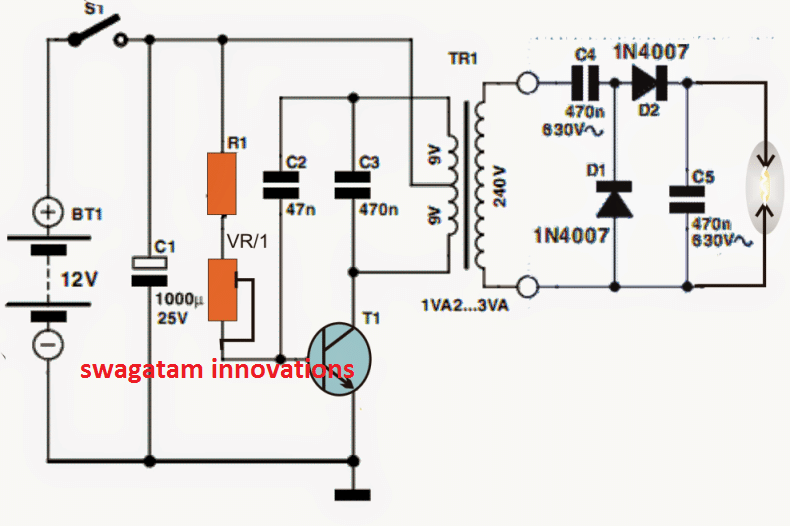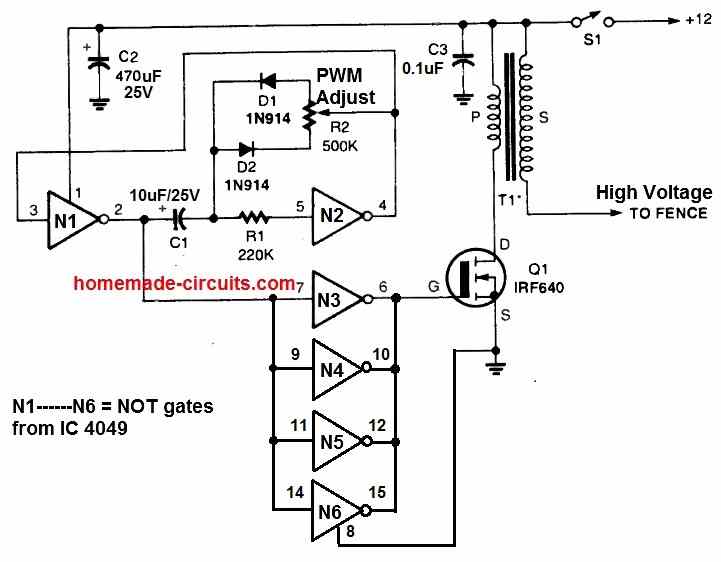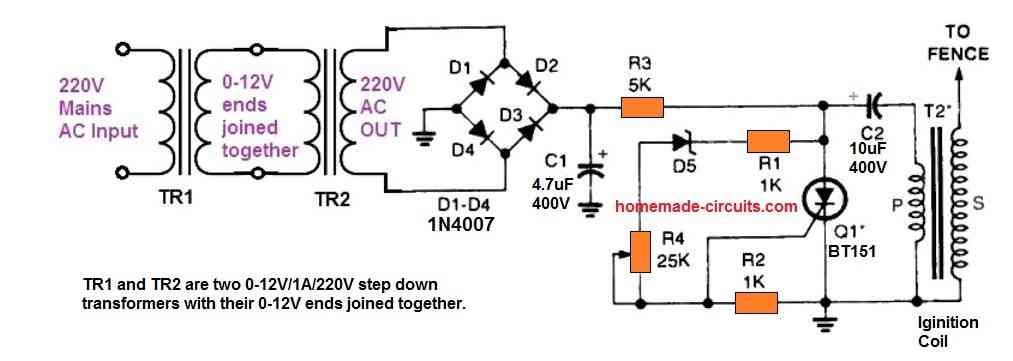A Homemade Fence Charger, Energizer Circuit | Homemade Circuit Projects
The electric fence charger circuit presented here is basically a high voltage pulse generator. The super high voltage is derived from a commonly used automobile ignition coil.
An astable multivibrator is used to generate the required frequency to drive the ignition coil. Another astable is used to control the pulses supplied to the fence.

Mục Lục
Protecting Crops with Fence Charger
If you have large agricultural fields and desperately need to protect the crops from uninvited guests like animals and possibly humans, then this electric fence charger device is just what you are looking for. Build and install it yourself.
An electric fence is an electrified high voltage barrier which produces painful shocks if physically touched or manipulated. Thus such fencing basically function as deterrents for animals as well as human intruders and stop them from crossing the restricted boundary.
The present circuit of an electric fence charger is designed and tested by me and has proved sufficiently powerful for the application.
20 kV from the Sparks
The fence charger circuit is able to produce voltage pulses up to 20,000 volts, needless to say about the fatality rate involved with it. However the pulses being intermittent, provides the subject with enough time to realize, recover and eject.
The generated pulse is so powerful that it can easily arc and fly-off between short distances of around a cm. so the fencing conductor needs to be separated adequately to avoid leakages through arcing and sparking. If not tackled, may drastically reduce the effectiveness of the unit.
Here the generation of high voltage is primarily carried out by an automobile ignition coil.
The winding ratios of an ignition coil are specifically designed and intended for creating high voltage arc between a two closely spaced conductors inside the ignition chamber to initiate the ignition process in vehicles.
Basically it’s just a step-up transformer, which is able to step-up an input applied voltage at its primary winding to monstrous levels at its output or the secondary winding.
WARNING: SOME POINTS OF THE CIRCUIT AND THE IGNITION COIL IS VERY DANGEROUS TO TOUCH WHEN POWERED. ESPECIALLY THE IGNITION COIL OUTPUT IS TOO LETHAL AND MAY EVEN CAUSE PARALYSIS. APPROPRIATE CAUTION IS STRICTLY RECOMMENDED. THE AUTHOR CANNOT BE HELD RESPONSIBLE FOR ANY MISHAP.
Let’s diagnose the proposed electric fence charger circuit more deeply.
Circuit Operation
In the CIRCUIT DIAGRAM we see that the entire circuit is basically comprised of four stages.
A DC oscillator stage,
An intermediate 12 to 230 volts step-up stage,
The voltage collector and firing stage and the super high voltage-booster stage.
TR1 and TR2 are two normal step-down transformers whose secondary windings are connected through SCR2. TR1 input primary winding may be selected as per the country specification.
However, TR2 primary should be rated at 230 volts.
IC 555 along with the associated components forms a normal astable multivibrator stage. The supply voltage to the circuit is derived from the secondary of TR1 itself.
The output from the astable is used to trigger the triac BT136 and the whole system, at a particular fixed intermittent rate as per the settings of P1.
During the ON periods, the triac connects the 12 volt AC from TR1 to the secondary of TR2 so that a 230 volt potential instantly becomes available at the other end of TR2.
This voltage is fed to the voltage-firing stage consisting of the SCR1 as the main active component along with a few diodes, resistor and the capacitor C4.
The fired voltage from SCR1 is dumped into the primary winding of the ignition coil, where it is instantly pulled to a massive 20,000 volts at its secondary winding. This voltage may be suitably terminated into the fencing.
The high voltage generated by this electric fence charger will need to be carefully applied across the whole length of the fence.
The two poles from the ignition coil connected to the fence wiring should be kept at least 2 inches apart.
The pillars of the fence should be ideally made of plastic or similar non conducting material, never use metal and not even wood (wood tend to absorb moisture and may give path to leakages).
Parts List for the explained electric fence charger circuit using SCR
- R4 = 1K, 1WATT,
- R5 = 100 OHMS, 1WATT,
- P1 = 27K PRESET
- C4 = 105/400V PPC,
- ALL DIODES ARE 1N4007,
- IC = 555
- TR1 = 0-12V/3Amp (120 or 230V)
- TR2 = 0-12V/1Amp (120 or 230V)
- THE SCR IS BT151,
- THE TRIAC COULD BE ANY 1AMP/400V SUCH AS BT136
- TWO WHEELER IGNITION COIL IS SHOWN IN FLUORESCENT BLUE COLOR
The above concept can be also implemented using a BJT for the generating the triggering pulses for the transformer, as shown below
Please increase the TIP122 base resistor value to 10K for reducing increased dissipation from the transistor.
Adjust the 1M pot such the ON time of the IC 555 is much shorter than the OFF time, for reducing current consumption.
Video showing how an Ignition Coil could be applied for producing high voltage
Mini Fence Charger Circuit
The discussed fence charge above is relatively lager and stronger with its specifications, if you need something smaller, then the following mini fence charger circuit can be quite handy, an may be used for driving away pests like cockroaches, slugs, worms, snails from any desired small premise such a terrace garden, balcony pot plants or simply for guarding food stuffs etc.
Circuit Operation
The referred circuit for the mini fence charger is shown below, it may be understood with the help of the following points:
The top part of the transformer winding basically delivers a reinforcement to the base of the transistor by means of C2 the T1 keeps being confined on to the conduction status until C2 charges completely, ending the latch and compelling the transistor to commence the conduction sequence afresh.
R1 that may be a 1K resistor is installed to restrict the base gain for T1 to secure inhibits whereas VR1 that could be a 22k preset could very well be tweaked for acquiring an effectively pulsating T1 rate.
C2 could be additionally fine tuned by attempting supplementary values until the maximum output is accomplished at the trafo output
Transformer Specs
The transformer could possibly be any iron-cored step down transformer (500mA) commonly employed in transformer version AC/DC power supply devices.
The output immediately across the transformer output may be at the evaluated secondary level, for instance whether it is a 220V secondary, in that case the output could possibly be anticipated to be with this levels.
The above degree could possibly be even more heightened or stepped up by means of the connected diode, capacitor charge pump set-up corresponding to cockroft-walton power generator system.
The set-up boosts the 220V level to scores of volts that could be compelled to spark across an accordingly deployed finish terminals of the charge pump circuit.
The above end high tension end terminals could be appropriately wired up across the whole length of the area which needs to be guarded from the bugs and for implementing the intended fencing charging operations.
The fence charger wires must be separated by some minimum distance so that the sparks do no keep flying of even in the absence of any external intrusion from the insects.
The explained mini fence charger circuit concept could be furthermore utilized in mosquito swatter bat purpose by swapping the iron cored transformer with a ferrite core counterpart.
Circuit Diagram

Using 4049 IC

Since the above fence charger can operate with a 12V battery, it is a suitable option for remote locations which may lack an access to AC power.
An oscillator circuit is constructed using two NOT gates N1 and N2 from a 4049 hex-inverting integrated circuit. It has a PWM control feature using the pot R2. This can be used to fine-tune the output PWM to optimize output voltage and performance of the fence charging.
The MOSFET switches to ground whenever the positive pulse of the input at Q1’s gate is available, connecting the primary winding of T1 across the 12 volt source.
When the MOSFET gate signal turns logic low, the current between Q1 and the transformer’s primary is inhibited. This causes a high voltage pulse to be produced through T1’s secondary winding.
This causes a high voltage in the order of around 20 kv to be generated at the output of T1. This output can be linked with the fence for the intended electrification.
Remember, T1 can be any automobile ignition coil. We recommend using a two-wheeler ignition coil.
How to Setup
- Setting potentiometer R2 to its half way is the easiest technique to optimize output arc and circuit performance.
- Next, hook up a DC current meter in series with the circuit and power supply positive.
- T1’s output is then positioned approximately half an inch above the ground line of the circuit.
- Finally, R2 is adjusted for getting optimum output voltage spark and lowest current consumption by the circuit.
Fence charger circuit using SCR and Ignition Coil

Another simple design of a fence charger circuit is shown in the above figure. This circuit is designed to work with a 220V or a 120V AC input. So, this circuit can be used only in places where an AC outlet is available.
The SCR along with the capacitor C2 forms a capacitive discharge circuit, which works with a 310V DC input.
The 310 V from a 220 V RMS input or a 170 V from a 120 V RMS peak voltage inputs is achieved through two step down transformers connected back to back.
TR1 and TR2 transformers are two 0-12V/1A/220V/120V transformers configured with their 0-12V ends attached together.
This allows the circuit to get a high voltage low current peak DC supply input for the intended capacitive discharge operations.
When AC power is switched ON, the 220V or 120V from TR2 is converted into the required high voltage peak supply via the bridge rectifier and the capacitor C1.
The peak DC passes through R2 and the primary side of the ignition coil until C2 is fully charged. When charged fully it develops sufficient voltage to switch ON the zener diode D5.
D5 now conducts and fires the SCR. The SCR triggers ON and discharges C2 through it. This instantly causes the stored peak DC inside C2 to suddenly pass through the ignition coil primary.
This in turn causes an equivalent high voltage in the order 20 kV to be induced on the secondary side of the ignition coil. This 20 kV generated output is used for electrifying or charging the intended fences.
Simplest Fence Charge using Just a Couple of Capacitors
If you have an access to a 220V AC or 120V AC mains input within reach, then perhaps the following simple capacitor based AC fence energizer circuit could be used for the purpose without incorporating any kind of complex circuitry.
The capacitor may be selected depending on the level of electric shock needed for the application.
Note: Although capacitors are used for dropping the input current to significantly lower levels, still the output from this system may be large enough to kill any living thing if it happens to get stuck or entangled in the fence and is subjected to the current for a longer duration of time.















![Toni Kroos là ai? [ sự thật về tiểu sử đầy đủ Toni Kroos ]](https://evbn.org/wp-content/uploads/New-Project-6635-1671934592.jpg)


